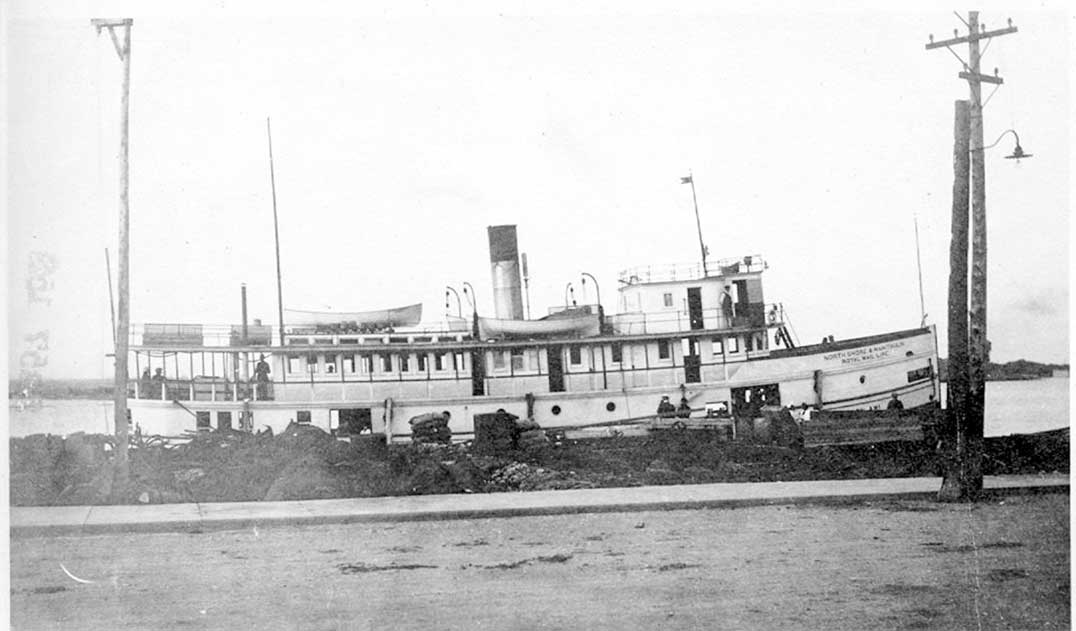MANITOULIN—In our not-so distant past the steamship was vital to life on Manitoulin Island, as they were throughout most of Northern Ontario, transporting all forms of goods to and from early settlers in remote areas so they could thrive. I was born on Manitoulin Island and have a fondness for the Island’s history, so I’ve been compelled to try and capture a bit of that past in some small way. My most recent project is this 1/87th scale model of a steamer named ‘Bon Ami.’
The Bon Ami was originally built in Wisconsin in 1902 as the ‘Mariposa,’ a tugboat, according to the writings of Bill Sims, the son of Thomas C. Sims. Thomas, along with his brother Charles L.D. Sims, co-owned the 118-foot Bon Ami from 1909 to 1921. Renamed the Bon Ami, she was converted to a passenger steamer at Soo, Michigan in 1909 at a cost of $18,000 and was then put into service bringing mail, livestock, supplies and even automobiles to Manitoulin and North Shore ports. Built from seven-inch-thick blue oak, the Bon Ami was a formidable ship for its size; so strong that she was often used to break up ice in the waters of the North Channel in early spring.
On regular service, she covered a daily service route between Cutler, Spanish Mills, Little Current and Manitowaning. The ship carried the mail for about 11 years, until 1921 when she was sold and renamed the ‘Islet Prince’ and put on Lake Superior service. Mr. Noble, a commercial fisherman, regularly sent his catch to Cutler on the Bon Ami and the boat would then return to its home port of Little Current. In late April of 2017, I was inspired by the history of this ship and came up with the idea of constructing a scale model. Having built several boat models based on local shipping before this one, I had the desire to build the model based on the fact that the Bon Ami was based at Little Current on Manitoulin Island.

Inquiring online about the Bon Ami in various locations, I was able to obtain several quality images of it that would aid in creating a blueprint for my model from Mrs. Shelley Pearen, the great-granddaughter of Thomas C. Sims. After discovering that blueprints of the Bon Ami no longer exist (that I am aware of) this was a key discovery to making the model a reality. My son Jeremy took the best straight-on broadside digital image of the ship, then warped and scaled it to 1/87th size using Adobe Photoshop. The altered image provided me with a rough guide from which I could render new drawings for the construction of my model.
Construction of my model of the Bon Ami started on May 8, 2017. Since I planned to display it on my model railway layout, the Bon Ami model wasn’t made with a fully rounded hull, but as a “waterline” model, flat on the bottom to what would be a typical height of the waterline on the ship’s sides. I began by constructing just the base of the hull using a pine board. I cut and sanded it to be as close as possible to the curvature of the old steamer. The sides of the upper portion of the main deck, the upper deck and the wheelhouse were made from copies of the Bon Ami photo glued to cereal box cardboard. When all the sections were glued in place, I covered the cardboard frame with 1”x6” scale strip wood from Mount Albert Scale Lumber. This strip wood represents the 6” boards used to cover the frame and walls of the original Bon Ami steamer.
Using an Exacto knife, I then cut out all the windows and doors out from the walls. Clear plastic styrene was glued over the window openings to represent windowpanes. Brass portholes, railings and the anchors were purchased from an online store called Cast Your Anchor. The portholes were press fitted into pre-drilled holes in the hull. Various items such as the smokestack, whistle, searchlight, masts, flag poles, navigation lamps, lifeboats, lifeboat davits, stove pipes, deck water tank, fenders, steering pole, anchor davit and the main deck railings were manufactured by myself. To construct those items, I used brass rod and tube stock of various sizes and Mount Albert Scale Lumber obtained from George’s Trains, my favourite hobby store. My son Jeremy once again used his computer skills to create the ship’s signage and flags on his computer.
Throughout the construction process, I sprayed on a base coat of grey primer then airbrushed or hand brushed water based colours such as white, dark green, etc. as required. Preiser of Germany manufactured the figures of people that you see on the inside and on the decks of the photo of my model.
Completed on January 9, 2018, my finished model of the Bon Ami was photographed in the small harbour on my model railway layout; docked at a fictional town that I call Conley’s Corners, in honour of one of the families on the Island that my family were friends with. Although I’m not able to resurrect the real thing, looking at this scene makes me feel like I’m closer to putting myself in the shoes of my Island ancestors; peering into a world that would have been very familiar to them. It also transports me back to Manitoulin the Island in an instant, even though I am now quite far away.
Special thanks go out to Shelley Pearen for providing me with the invaluable photos and information on the Bon Ami.




